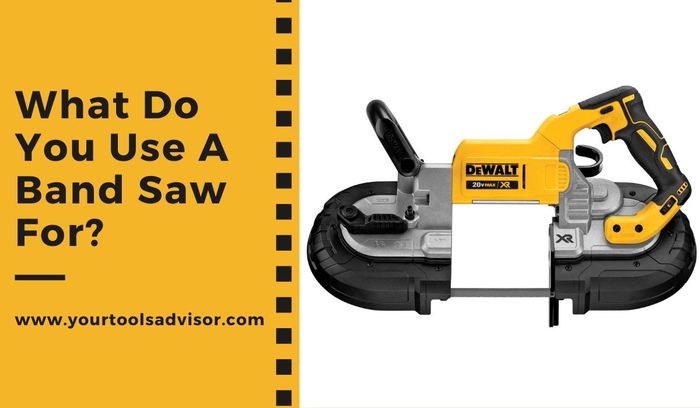A band saw is a crucial tool in the arsenal of craftsmen, woodworkers, and metalworkers alike. With its ability to cut irregular shapes, straight lines, and make curved cuts, the band saw offers unrivaled versatility in many industries.
This power tool can handle a wide range of materials, including wood, metal, and plastic, making it invaluable for projects of all kinds.
A band saw is used for cutting irregular shapes, straight lines, and making curved cuts in various materials, such as wood, metal, and plastic. It is a versatile power tool commonly used in woodworking, metalworking, and fabrication industries.
From crafting intricate designs in woodworking to quickly and accurately slicing through metal pipes, the applications of a band saw are vast.
In this post, we are going to share a detailed discussion on what do you use a band saw for. Also, we will try to delve into the many uses of a band saw and explore its importance in various industries.
Whether you’re a DIY enthusiast or a professional, understanding the capabilities of a band saw is essential for achieving precise and efficient results.
So, let’s uncover the secrets behind this powerful cutting tool and discover how it can enhance your projects…
Basics Of A Band Saw
When it comes to woodworking and metalworking, having the right equipment is essential. One such versatile and powerful tool is the band saw.
A band saw consists of a continuous band of toothed metal that moves around two or more wheels to cut various materials with precision.
Understanding the basics of a band saw is crucial for any DIY enthusiast or professional worker aiming to make accurate and clean cuts.
How Does A Band Saw Work?
A band saw operates using a simple yet effective mechanism. The blade, a continuous loop with teeth, is mounted on two wheels that rotate as the motor powers the machine.
As the operator guides the material through the blade, the teeth of the band saw cut into the material, creating a smooth and precise cut.
The adjustable speed and tension of the blade allow for versatility in cutting different materials and thicknesses, making the band saw a go-to tool for woodworkers and metalworkers alike.
Components Of A Band Saw
A band saw comprises several important components that work together to facilitate smooth and accurate cutting:
- Wheels: The wheels maintain tension on the blade and control its movement, one acting as the drive wheel and the other as the idler wheel.
- Blade: The blade is the heart of the band saw. It consists of a continuous loop of steel with teeth on one side, responsible for cutting through various materials.
- Table: The table provides a stable and flat surface for the material being cut. It can be tilted and adjusted to accommodate different cutting angles.
- Guides: The guides or bearings keep the blade in proper alignment, minimizing deflection and enhancing cutting accuracy.
- Fence: The fence acts as a guide for materials to ensure straight and precise cuts. It can be adjusted depending on the desired width of the cut.
- Motor: The motor powers the band saw, providing the necessary rotational force for the wheels and blade, enabling smooth cutting.
What Do You Use A Band Saw For?
The band saw, a versatile and powerful tool, has earned its place as a cornerstone in woodworking shops, metalworking shops, and even some advanced DIY enthusiasts’ tool arsenals. Its unique design, featuring a continuous looped blade stretched between two wheels, grants it exceptional cutting capabilities across a wide range of materials.
From intricate curves to straight cuts, the band saw’s precision and efficiency make it an indispensable asset for craftsmen and artisans alike.
At this point, we’ll delve into the various applications of a band saw, shedding light on its diverse uses and highlighting the key benefits it brings to the table.
Whether you’re a seasoned professional or a curious beginner, understanding the capabilities of a band saw can open up a world of creative possibilities in your projects.
Woodworking Applications For Band Saws
The band saw is an essential tool in any woodworking shop, providing versatility and precision for a wide range of cutting tasks. Whether you are a professional woodworker or a passionate hobbyist, a band saw can greatly enhance your woodworking projects.
In this section, we will explore some of the key woodworking applications for band saws.
Cutting Curves And Shapes
One of the primary reasons woodworkers choose to use a band saw is for its ability to cut curves and shapes. The continuous blade motion of a band saw allows for intricate and precise cuts that would be difficult to achieve with other tools.
Whether you’re working on creating graceful curves for furniture legs or cutting out intricate patterns for decorative accents, the band saw is a go-to choice.
Woodworking applications for cutting curves and shapes using a band saw include:
- Creating curved chair legs
- Cutting intricate designs for scrollwork
- Shaping wooden puzzles and toys
- Forming decorative moldings and trim pieces
Resawing And Ripping
Besides its ability to cut curves, a band saw is also highly effective for resawing and ripping wood. Resawing involves cutting a thicker piece of wood into thinner pieces, while ripping is the process of cutting a board parallel to its grain.
These applications are essential for creating veneers, lumbers, and obtaining specific dimensions for various woodworking projects.
Woodworking applications for resawing and ripping using a band saw include:
- Making veneers for furniture and cabinetry
- Producing lumber for woodworking projects
- Creating thin boards for box making or scrollwork
- Preparing stock for laminating
Creating Joinery
In addition to cutting curves and shapes and resawing, band saws are indispensable for creating intricate joinery. From simple cuts like tenons and lap joints to more complex joints like dovetails and box joints, a band saw provides exceptional precision and control for achieving seamless connections between woodwork pieces.
Woodworking applications for creating joinery using a band saw include:
- Producing tenons for mortise and tenon joinery
- Cutting box joints for drawer construction
- Crafting dovetails for strong and visually appealing joints
- Creating spline joints for added reinforcement
With its versatility and accuracy, a band saw is an indispensable tool for any woodworking project.
Whether you need to cut curves and shapes, resaw and rip wood, or create intricate joinery, incorporating a band saw into your woodworking arsenal will undoubtedly elevate your craftsmanship to new heights.
Metalworking Uses For Band Saws
Band saws are indispensable tools in metalworking. From cutting intricate shapes and curves to ripping and resawing, band saws offer precision and versatility for various metalworking applications.
Cutting Various Metals
A band saw is a versatile tool that finds numerous uses in metalworking. One of its primary functions is cutting various types of metals precisely and efficiently. Whether it’s steel, aluminum, or other metal alloys, a band saw equipped with the right blade can handle the task with ease.
The band saw’s unique design allows for straight cuts, curves, and even intricate designs, making it ideal for projects that require precision.
Precision Metal Shaping
In addition to cutting metals, a band saw also serves as a valuable tool for precision metal shaping. With the ability to make both straight and curved cuts, the band saw allows metalworkers to create intricate shapes and designs.
Whether it’s crafting delicate metalwork for jewelry or sculpting unique metal pieces for architectural elements, the band saw offers the precision and control necessary for achieving the desired outcome.
Metal Fabrication
When it comes to metal fabrication, a band saw is an indispensable tool. Its ability to cut through various metals allows metalworkers to efficiently produce parts or components needed for larger projects. Whether it’s cutting tubes, bars, or solid metal sheets, the band saw enables metal fabricators to work with precision and speed, ensuring the accuracy and quality of the final product.
Sharpening Tools
In addition to its cutting and shaping capabilities, a band saw can also be used for sharpening metalworking tools. Metalworkers often rely on sharp and precise tools to carry out their work effectively.
With the appropriate attachments and grinding wheels, a band saw can be transformed into a tool-sharpening machine. From drill bits to chisels and even saw blades, the band saw can restore the sharpness of various metalwork tools, saving time and effort in the process.
In conclusion, a band saw is an essential tool in the realm of metalworking. Its ability to cut various metals, shape them with precision, aid in metal fabrication, and even sharpen tools makes it a valuable asset for metalworkers.
Whether you are a professional metal fabricator or a DIY enthusiast, a band saw offers versatility, accuracy, and efficiency, helping you accomplish your metalworking projects with ease.
Common Uses Of Band Saws In Construction
A band saw is an essential tool in the construction industry, offering precise and efficient cutting capabilities. Its versatility makes it a popular choice for various applications, allowing builders and contractors to tackle a wide range of projects with ease.
In this section, we’ll explore some of the common uses of band saws in construction, highlighting their importance in different tasks.
Cutting Lumber And Plywood
When it comes to working with lumber and plywood, a band saw is an invaluable tool. Its powerful motor and sharp blade allow for straight and accurate cuts through these materials, ensuring clean edges and precise dimensions.
From creating crosscuts and rip cuts to intricate curved designs, a band saw provides the control and versatility needed to handle any woodworking project.
Trimming Door Frames And Windows
Trimming door frames and windows to fit perfectly is a task that requires precision and attention to detail. Band saws excel in this area, allowing builders to make clean and precise cuts, even in tight corners and intricate patterns.
With adjustable blade guides and a stable cutting platform, a band saw ensures smooth and accurate trimming, resulting in seamless installations and improved aesthetic appeal.
Working With Plastic Materials
Beyond wood, band saws also excel in cutting various plastic materials commonly used in construction projects. Whether it’s PVC pipes, acrylic sheets, or plastic panels, a band saw provides the control and accuracy needed to handle these materials efficiently.
The ability to adjust blade speeds and select appropriate blades for different types of plastics further enhances the versatility of band saws in working with plastics.
Making Custom Moldings
Custom moldings add a touch of elegance and uniqueness to any construction project. Band saws play a crucial role in creating these customized moldings, allowing builders to shape and cut different profiles with ease.
By using versatile fence systems and specialized blades, a band saw ensures that each molding piece is precisely cut, delivering consistency and accuracy throughout the project.
Alternative Applications Of Band Saws
A band saw is commonly associated with woodworking and metalworking tasks, where it is primarily used to make straight cuts, curves, and intricate patterns. However, this versatile tool also has various alternative applications that may surprise you.
In this section, we will explore five alternative uses of band saws, showcasing their versatility and potential in different industries.
Cutting Foam And Insulation
Band saws can be a valuable tool when it comes to cutting foam and insulation materials. The precise and controlled cutting action of a band saw allows for clean and accurate cuts, making it ideal for trimming and shaping materials such as foam board, insulation panels, and even rubber sheets.
With a suitable blade and the proper settings, a band saw can swiftly slice through these materials, providing a neat and professional finish.
Sculpting And Shaping Plastics
Band saws can also be used for sculpting and shaping various types of plastics. Whether you are working with acrylic, polycarbonate, or even PVC, a band saw can be an excellent tool for cutting intricate shapes and curves in these materials.
Its ability to make detailed cuts with minimal wastage makes it a popular choice among artisans, craftsmen, and even DIY enthusiasts who work with plastic.
Trimming And Preparing Meat And Bone
Band saws find surprising applications in the food industry as well. Specifically, when it comes to trimming and preparing meat and bone. These powerful tools can be used to efficiently and precisely cut through bulkier cuts of meat or bone, making portioning easier and more consistent.
Their ability to handle different types of cuts, from thick ribbons to tenderloins, makes them invaluable in commercial kitchens, butcher shops, and meat processing plants.
Maintenance And Repair Applications
Band saws can also be used for maintenance and repair applications across various industries. Whether it is cutting through rusty or old pipes, removing damaged sections of wood or metal, or even making modifications to existing structures, band saws offer the necessary power and precision.
Their ability to cut through tough materials quickly allows for efficient repairs and maintenance tasks, saving time and effort.
Moreover, band saws can also be used for blade repair and maintenance. With the right tools and skills, users can sharpen and set band saw blades to ensure optimal performance, prolonging their lifespan and reducing the need for frequent replacements.
FAQs On What Do You Use A Band Saw For
What Can A Bandsaw Be Used For?
A bandsaw is a versatile tool used for cutting curved or straight lines in various materials, such as wood, metal, or plastic.
Its unique design allows for precision and control, making it ideal for tasks like resawing lumber, creating intricate shapes, and making detailed cuts in woodworking and metalworking projects.
What is the main use of band saw?
The main use of a band saw is to make precise and curved cuts in various materials such as wood, metal, or plastic. It is a versatile tool commonly used in woodworking, metalworking, and other industries for its ability to create intricate shapes and designs.
What do you use a bandsaw to cut?
A bandsaw is used to cut various materials such as wood, metal, and plastic. It is especially well-suited for making curved or irregular cuts due to its versatile blade design.
Why Use Band Saw Instead Of Table Saw?
Band saws offer more versatility and precision cuts than table saws, making them ideal for intricate designs and curves. With their thinner blades and ability to adjust for different thicknesses, band saws excel in cutting irregular shapes and resawing. They are favored by woodworkers seeking finesse and flexibility in their projects.
How do you use a band saw?
To use a band saw, first, ensure the machine is properly set up and adjusted for the material you’re cutting. Adjust the blade tension, guides, and fence as needed. Hold the workpiece firmly against the fence and slowly feed it into the blade, keeping steady pressure.
Always wear safety goggles and follow manufacturer’s guidelines for safe operation.
What is the use of band saw blade?
A band saw blade is a cutting tool used in a band saw machine to make precise and curved cuts in various materials such as wood, metal, and plastic.
It is versatile and suitable for both intricate and straight cuts, making it an essential tool in woodworking, metalworking, and other industries.
Conclusion
A band saw is a versatile tool that can be used for a variety of tasks. From cutting curves and straight lines to ripping and resawing wood, this powerful machine can handle it all.
Whether you are a professional woodworker or a hobbyist, a band saw is a must-have tool in your workshop.
Its precision, power, and versatility make it an essential tool for any woodworking project.
So, if you’re looking to take your woodworking skills to the next level, investing in a band saw is definitely worth it.





Leave a Reply